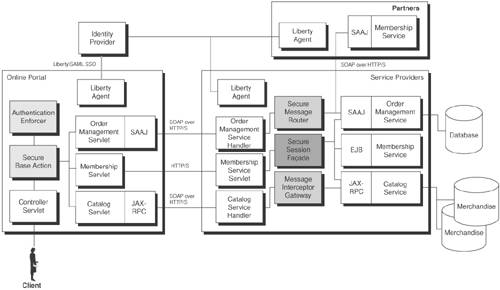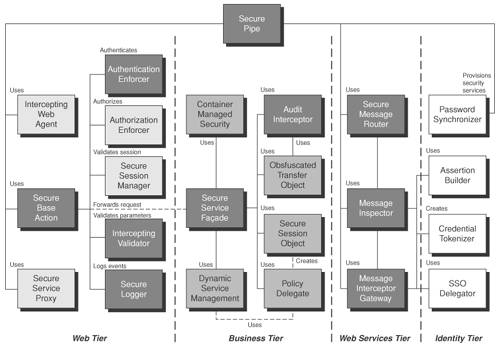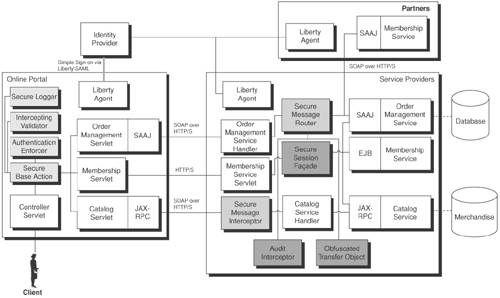Security Architecture
| After formulating a conceptual security model identifying the key security features, we need to define candidate security architecture that represents an architect's view of the eRewards portal security. This means that we will make further architecture decisions to support development that allow us to start to tie together the security components in a cohesive application architecture. We will not bore down to the object level, but we will start to define services and subsystems that contribute to the end-to-end security. Upon identifying the candidate security architecture, we will perform a detailed risk analysis and identify mitigation strategies. We will also perform a trade-off analysis to meet the security criteria and support the business and architectural decisions. Part of the job is already done. Due to business decisions, we have already decided to use a third-party identity management provider. This will drive a lot of the candidate architecture, because it imposes several constraints to begin with. Now we have to come up with a few high-level application components adopting security patterns. This will help us to illustrate candidate security architecture. Figure 14-5 shows the logical representation of candidate security architecture for the eRewards portal. We adopted the core security patterns to represent the key security requirements in the logical tiers of the application architecture. Figure 14-5. eRewards portal candidate security architecture In the Web tier, we will use a Secure Base Action pattern for centralizing and coordinating all security-related tasks with Web components such as JSPs and Servlets. We will make use of an Authentication Enforcer pattern to authenticate Web requests and to verify authentication information established by our third-party Identity Provider. In the Business tier, we will use a Secure Session Façade pattern that can contain and centralize all EJB interactions within a secure session. We will use an Obfuscated Transfer Object to protect the business data in a transfer object during transit. To ensure Web service communication with service providers, we will make use of the Secure Message Router pattern, which facilitates applying message-level and transport-level security mechanisms before sending messages to Order management service and Membership service. To ensure secure sending and receipt of messages with service providers, we will make use of the Message Interceptor Gateway and Message Inspector patterns that allow us to enforce security mechanisms at the transport-level and the message-level, and to verify messages for standards compliance and other content-level vulnerabilities. The candidate security architecture also consists of components at the network and host layers. Perimeter security design, DMZ architecture, patch management, and intrusion-detection systems are other key components that need to be part of the candidate security architecture artifacts. Because the scope of this book targets the application-level security solutions, we will assume that those tasks have been completed with as much due diligence, using known industry best practices. Risk Analysis and MitigationAfter deriving the candidate security architecture, we will analyze the architecture for known risks in terms of potential threats and vulnerabilities and identify mitigation strategies to avoid them. We will study the risksboth qualitative and quantitativelyin light of architecture tiers, possibility of occurrence (expressed in terms of the number of prospects), probability (expressed in terms of likelihood of possible occurrences), impact (expressed in terms of effect that affects the overall architecture), and exposure (expressed as the level of acceptability). We will also identify the issues that expose those potential risks and how to mitigate them by identifying potential security patterns, best practices, and solutions. Table 14-1 shows the risk analysis and mitigation strategies for a partial list of known risks and vulnerabilities. A complete risk-analysis document is available at the companion Web site (http://www.coresecuritypatterns.com).
In real-world scenarios, after the qualitative risk analysis, a quantitative risk analysis has to be performed. This helps identify all key risk elements and estimate the projected loss of value for each risk, such as infrastructure cost, potential threat, frequency, business impact, potential loss value, safeguard option, safeguard effectiveness, and safeguard value. Based on that information, we can estimate the potential losses and compute the annual loss expectancy (ALE), which helps to make a business case for identifying security countermeasures and safeguards. Refer to Chapter 8, "The Alchemy of Security DesignMethodology, Patterns, and Reality Checks," for more information about quantitative risk analysis. Trade-Off Analysis (TOA)After risk analysis, it becomes important to validate the quality of the security architecture, weighing the choices of security options, features, and alternatives. A trade-off analysis helps the security architect to make better decisions and allows justification of financial requirements that relate to the multiple security criteria, possible options, and recommendations. For the Web tier, we need to perform a trade-off analysis of SSL Encryption options. The factors we need to consider are price and performance. Table 14-2 shows the trade-off analysis of the different SSL Encryption options.
Table 14-3 illustrates the TOA effect matrix for weighing different choices for identifying a load-balancing option for the eRewards portal.
On the Business tier, we need to examine different data obfuscation strategies. The considerations for data obfuscation strategies include performance, security, and implementation costs. Table 14-4 shows the comparisons of the data obfuscation strategies.
A TOA artifact is also available at the companion Web site (http://www.coresecuritypatterns.com). Refer to Chapter 8, "The Alchemy of Security Design: Methodology, Patterns, and Reality Checks," for more information about trade-off analysis. Applying Security PatternsTo address the key security requirements defined at the beginning of the chapter, and based upon the outcome of our risk analysis and trade-off analysis, we have identified a set of security patterns for use within the application. These patterns are identified as part of the mitigation strategy identified for the associated risks. These patterns are highlighted (in black boxes) in Figure 14-6. Figure 14-6. eRewards portal application: security patterns used To mitigate known risks, the application architecture, including the Web portal and service providers, will make use of the following security patterns:
These patterns address the key security requirements and mitigate those identified risks that span the Web-, business-, and Web Service tiers. We specifically chose not to address implementations of the Identity tier because such implementations are best performed by the third-party Identity Provider that is chosen by the eRewards portal owner. In this portal scenario, the Identity Provider is identified as a Liberty-enabled security infrastructure whose implementation is not discussed. Other Security Patterns UsedTo address other security requirements of data confidentiality, data integrity traceability, auditability, and accountability specific to the infrastructure, we chose to use the following application security design patterns:
Security ArchitectureDetailed ComponentsSecurity services associated with the business services in the Web, business, and Web Services tiers address the security requirements of authentication, authorization, data privacy or confidentiality, availability, data integrity, and non-repudiation. The Client logs in with the Web portal, and the controller servlet manages the user interaction. The Authentication Enforcer and Secure Base Action patterns handle the user authentication (authentication) and redirect the user to the Identity Provider for authentication services (and thus for single sign-on). Upon successful authentication, the Client makes selections for browsing the online catalog, placing an order, or requesting order fulfillment for the merchandise ordered (see Figure 14-7). Figure 14-7. eRewards portal security architecturedetailed components In the portal, each exposed business service is represented using a servlet to handle the business processing. To interact with service providers, the servlets use JAX-RPC handlers to invoke remote Web services. In cases of service providers using the J2EE environment, the servlets communicate with their presentation components, such as JSPs and servlets to invoke their business EJBs. After enforcing authentication and authorization, the catalog servlet enables a Client to browse through the merchandise catalog and select specific product items to place into their shopping carts. The catalog servlet uses a JAX-RPC handler to invoke a remote catalog Web service over HTTPS. The Secure Message Interceptor pattern intercepts the SOAP message to examine the user credentials and signature in the SOAP service request (data privacy and data integrity). The order management servlet takes a product or a group of product items selected in the catalog service and places an order with the back-end order management system using a membership service servlet. It uses a membership servlet to retrieve the membership award balance and verify if the requesting Client is eligible and entitled to redeem the merchandise (authorization). The membership servlet communicates with the membership service servlet over HTTPS, which uses the Secure Session Façade pattern to delegate to the back-end membership service, which is implemented in EJBs. Upon successful verification of the membership award balance, the order management servlet will issue a document-style SOAP service request over HTTPS using a JAX-RPC handler to invoke the remote order management service. The handler will make use of a Secure Message Router pattern to route the SOAP messages to the relevant service providers or external partners, applying all required message-level security mechanisms. It ensures that the SOAP message is also encrypted and digitally signed to provide message-level confidentiality and integrity so that the message can be viewed only by the intended recipient. Web TierOn the Web tier, the Secure Pipe pattern was chosen to provide a secure communication channel. This protects communications between the client and the application from eavesdropping, man-in-the-middle attacks, and data injection or corruption. The Secure Base Action pattern is part of the entry point into the application and server to enforce security on the front-end in conjunction with other Web-tier security patterns. The Authentication Enforcer provides us with a means for encapsulating and decoupling the mechanism used for authentication from the actual establishment of the client's identity. Because the actual authentication is performed outside the application by a trusted external Identity Provider, the actual job of the Authentication Enforcer is simply to verify the trusted provider and its credentials. The encapsulation of the authentication mechanism assures us that if, in the future, authentication is moved back into the application, those changes will be isolated in one spot and not impact the rest of the Web tier. The Intercepting Validator is responsible for validating and cleansing the data passed in on the HTTP request. This provides protection from data corruption attacks such as SQL injection attacks, cross-site scripting attacks, and malformed requests aimed at crashing the site. Finally, the Secure Logger logs all of the relevant information about the request to a secure store so that if intruders did gain access to the application, they would not be able to alter the logs and conceal their attack. Business TierOn the Business tier, the Secure Session Façade pattern is used to provide a secure entry point into the business services. It has the responsibility of ensuring that auditing and any other security function is performed prior to service invocation. In this case, auditing is delegated to the Audit Interceptor, which audits service invocations, responses, and exceptions as defined declaratively. The Obfuscated Transfer Object is used to pass data between the Web tier and the Business tier and between service providers in the Business tier. It takes responsibility for obfuscating sensitive data passed back and forth, thereby removing that responsibility from service providers themselves. That way, credit card numbers, bank information, and other account details are not improperly written out to logs or the audit store. Web Service TierThe Web Service tier consists of the Secure Message Router, the Message Inspector, and the Message Interceptor Gateway. The Secure Message Router is used to provide message-level security between the portal and the trading partners. It configures the SSO capabilities between the partners and notifies them of global logout events. Additionally, it provides transformation of incoming messages to the message formats required by the service providers. The Message Interceptor Gateway sits in front of the Web Services interface to the application. It acts as a proxy and facilitates enforcement of channel-level security, including creation of SSL connections, IP verification, and some URL access control. It delegates data validations to the Message Inspector. | |||||||||||||||||||||||||||||||||||||||||||||||||||||||||||||||||||||||||||||||||||||||||||||||||||||||||||||||||||||||||||||||
EAN: 2147483647
Pages: 204